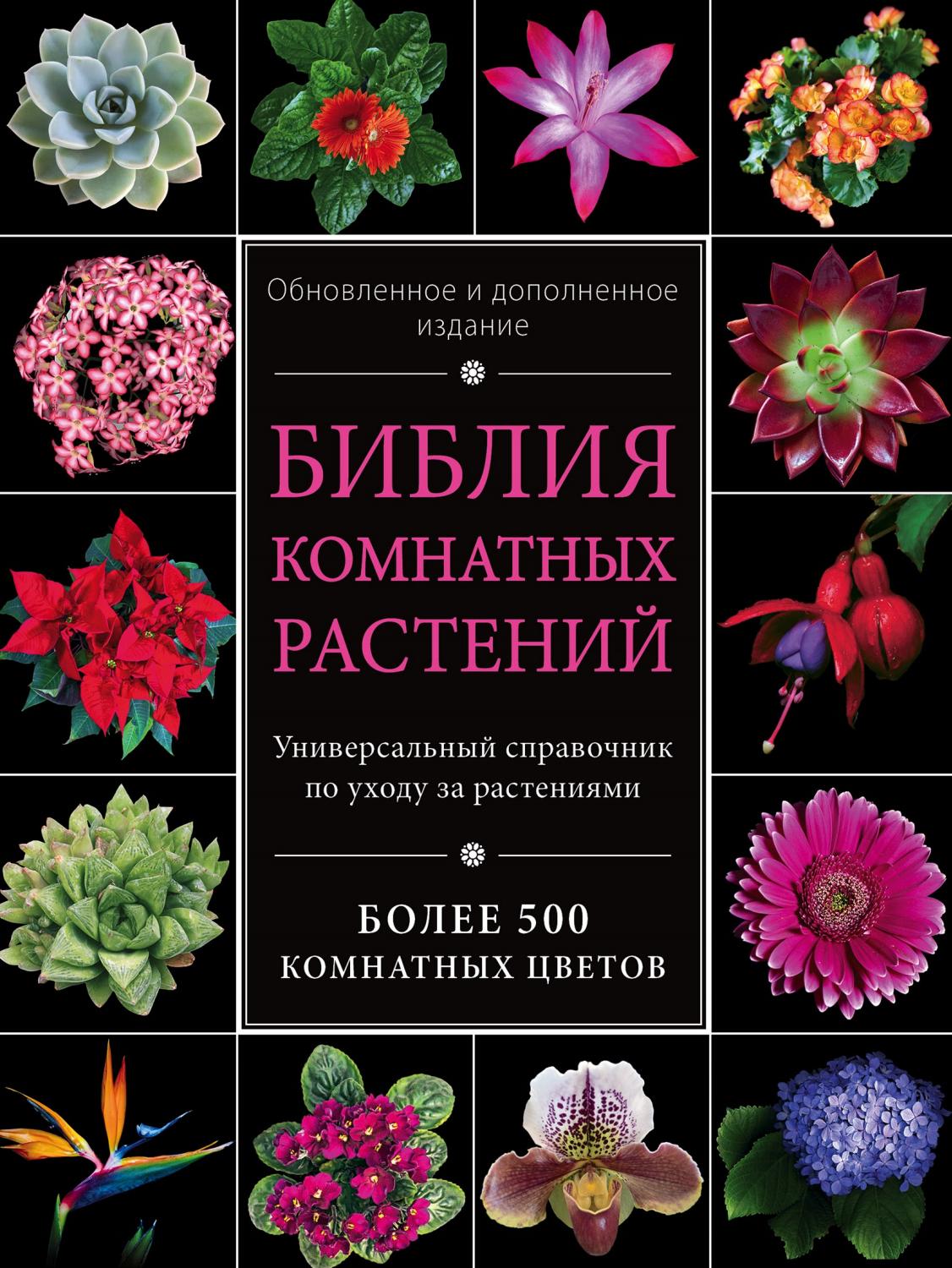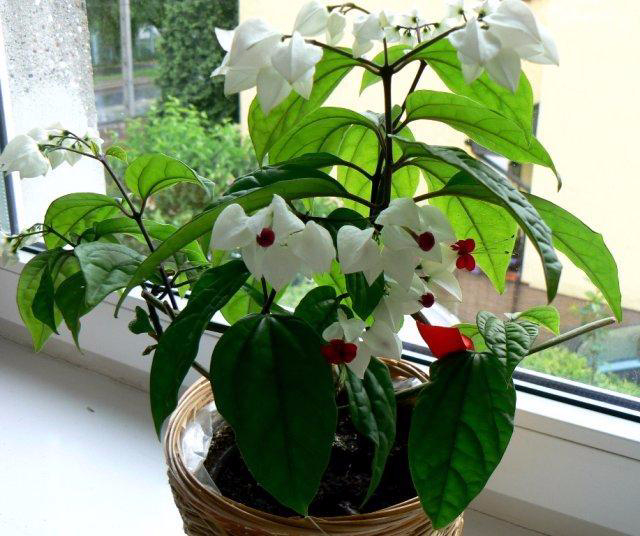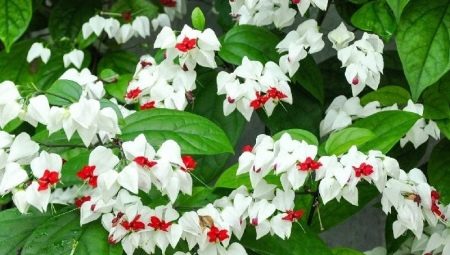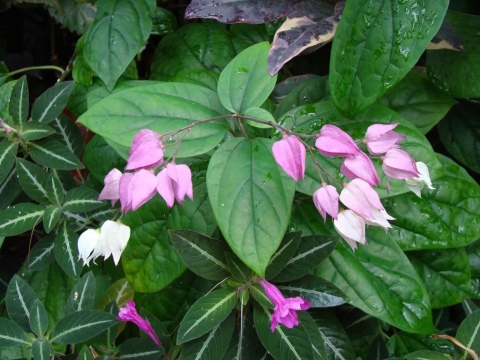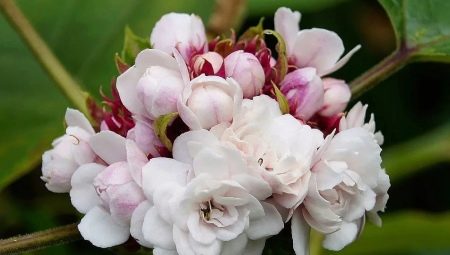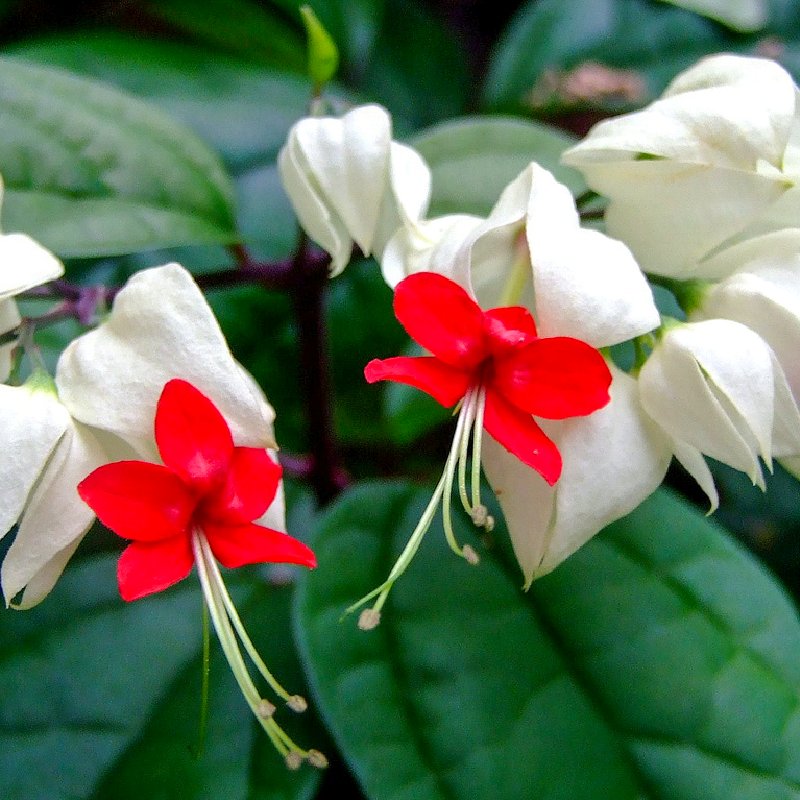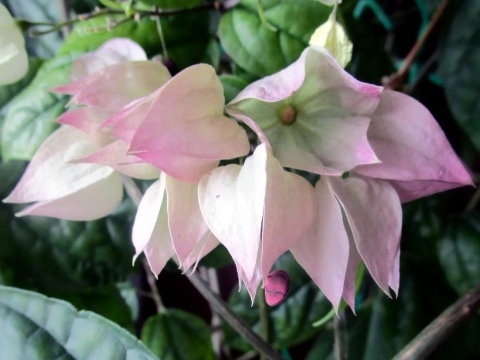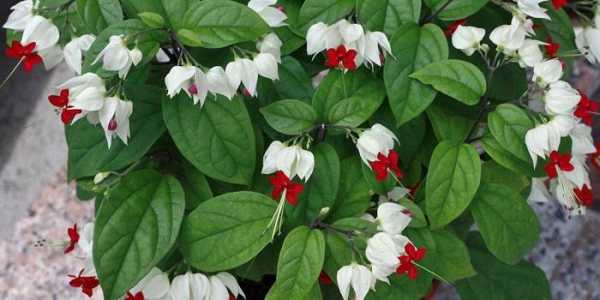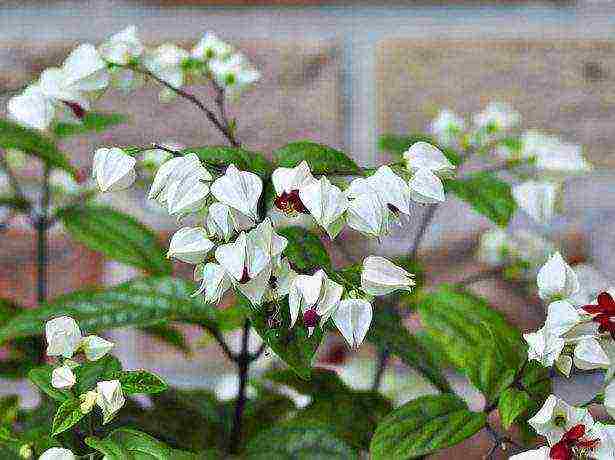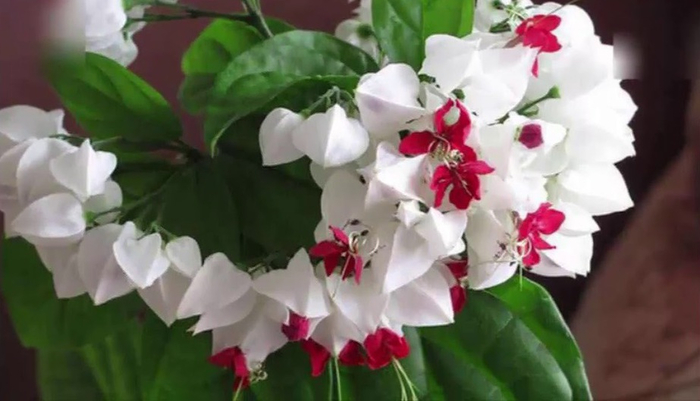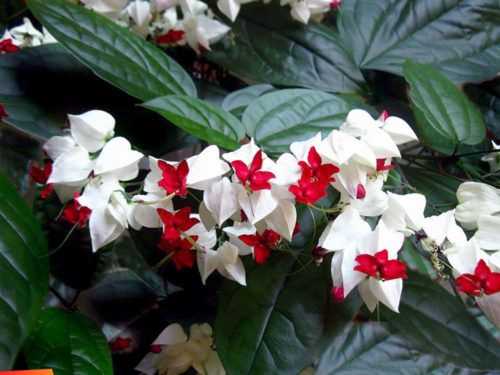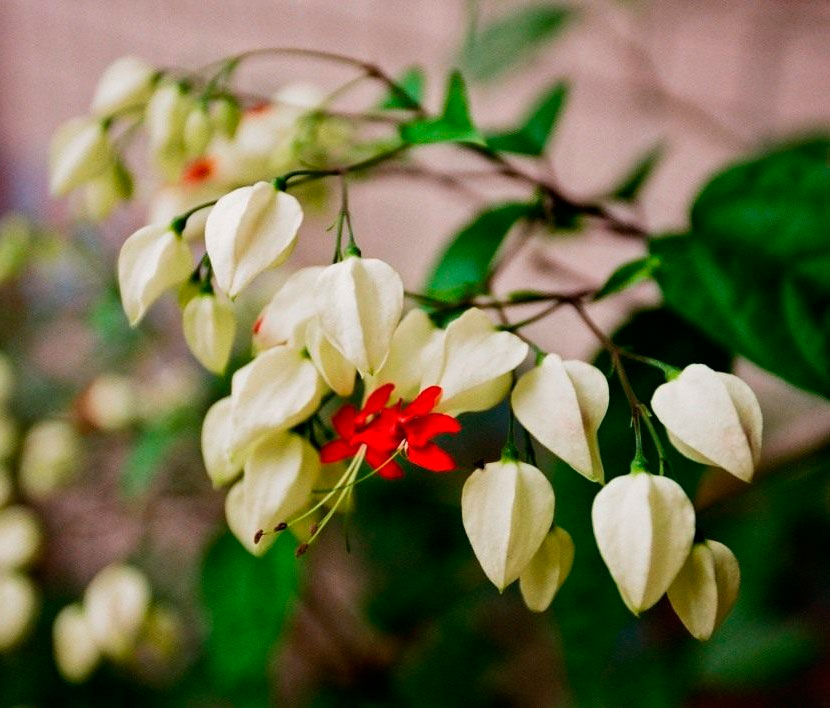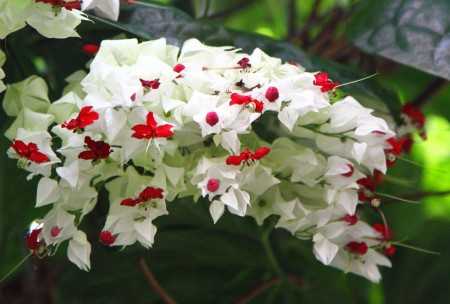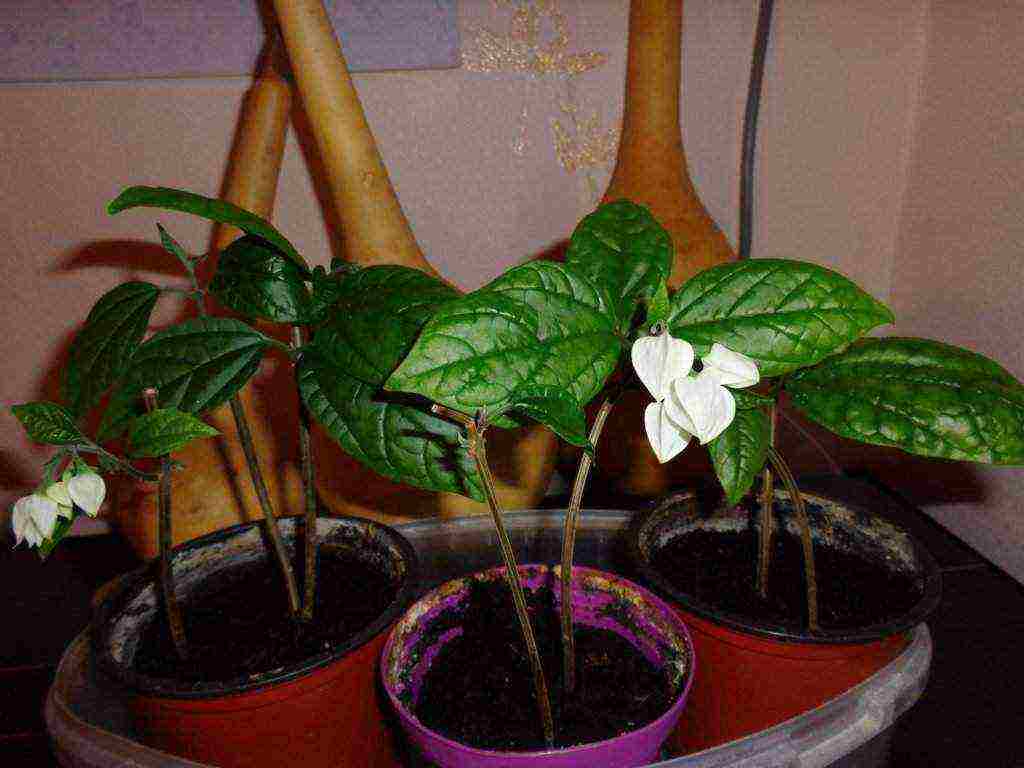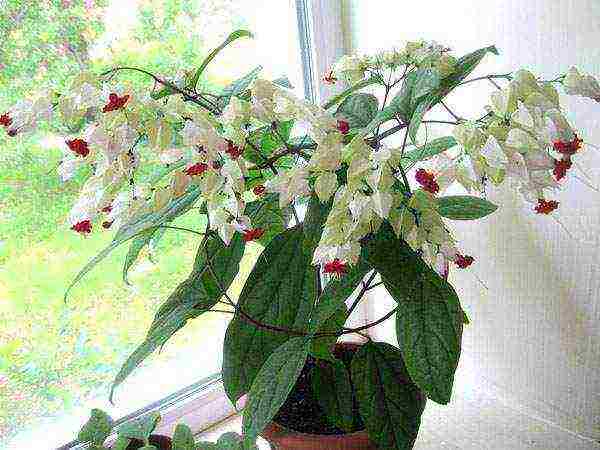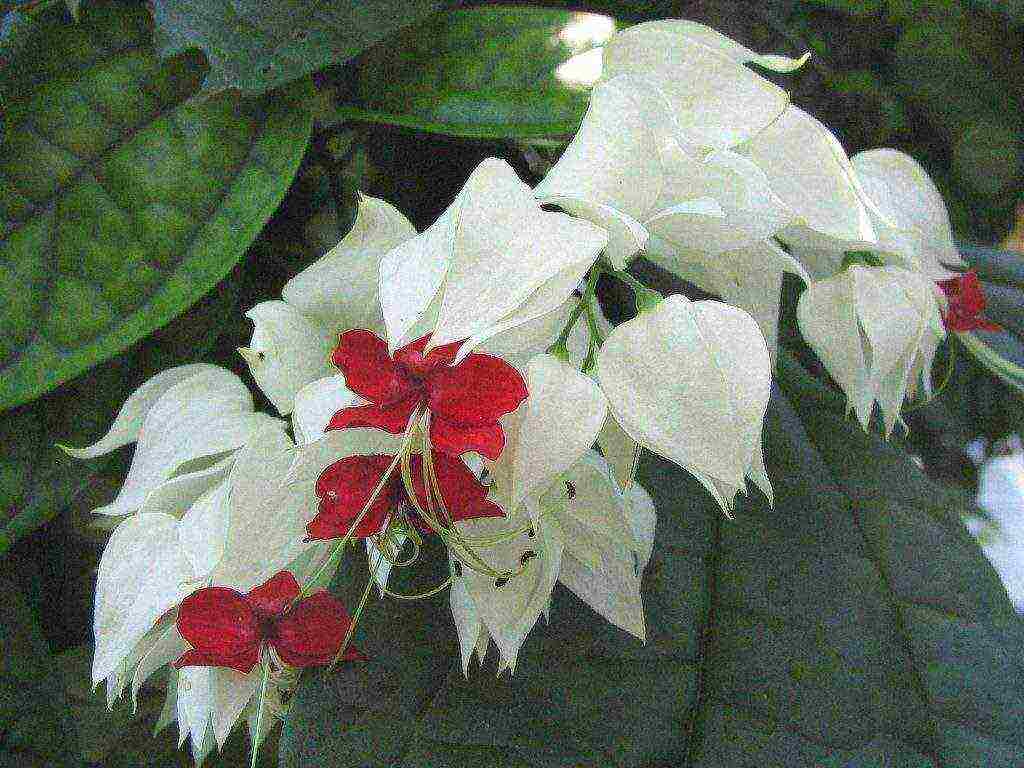How to care
Consider all the nuances of caring for Madame Thompson's clerodendrum.
Watering
It is important not to allow waterlogging of the substrate, since stagnation is contraindicated for clerodendrum. Root decay is a dangerous consequence that occurs due to regular waterlogging.
Water the flower only after the substrate dries noticeably on top.
However, proper care also means avoiding drought: especially when the flower is actively growing. In winter, watering can be reduced significantly, moistening the soil only when necessary. Keep one simple rule in mind when caring for clerodendrum: the lower the air temperature in the room, the less water the flower needs.
Water Thompson's Clerodendrum with only warm and soft water. From the tap, the water must first be defended before being used for irrigation.
Top dressing
Properly applied fertilizers will help the clerodendrum bloom longer and more luxuriantly. The recommended frequency of feeding is once every 2 weeks. Fertilizers are usually applied during the growing season: that is, from early March to mid-late September. By autumn, the amount and frequency of fertilization are reduced, and in winter they are not fed at all.
Alternate mineral supplements with organic humic ones. Of the minerals, the complex composition of "Agricola" is optimal: it should be used according to the instructions. From humic plants "FlorHumate" is suitable for flowering ornamental plants.
Minerals supply the plant with all the necessary substances for normal life. Organic fertilizing, however, saturates the soil with humus, makes the soil more fertile, and improves its biologically active properties.
Attention: be careful with nitrogenous fertilizing, since nitrogen promotes the formation of leaves, but at the expense of flowering
Pruning
With the help of competent pruning, you can form anything from a clerodendrum: even a climbing liana, even a compact shrub, even a small pretty tree.
When clerodendrum reaches adulthood, it needs regular pruning. The procedure helps to maintain the shape of the plant, and also provokes it to abundant long flowering. The optimal time is in spring, when the sap flow begins in the tissues of the flower. Usually the shoots are shortened by one third. Before shaping pruning, do not forget to carry out a sanitary one: remove all broken, diseased, thickening branches.
Young flowers cannot be pruned. But you can pinch the tops of the shoots so that the clerodendrum branches more strongly.
After the clerodendrum has bloomed for the second time in a season (usually in early September), all peduncles should be cut off. At the same time, the frequency of top dressing and watering decreases. Thus, the plant prepares for winter.
Important: in addition to the main pruning, you should also regularly pluck out the young root shoots that appear at the base of the trunk
Transfer
The procedure is carried out in early spring before the start of active growth. As a rule, the transplant is carried out in connection with the outgrowth of the old pot by the flower. Choose a new container larger than the previous one, but not by much.
Young clerodendrum is transplanted annually, as it grows very quickly. In adulthood, the plants are transplanted every two to three years: the gentle method of transshipment is optimal.
Dormant period
Thompson's Clerodendrum, like most of its species, needs a dormant period.This period begins in November-December and lasts approximately until March.
Top dressing and watering at this time are rare. You can stop applying fertilizers altogether, but watering is still sometimes necessary. It is imperative to keep the plant in cool conditions in winter: this is the key to the future lush flowering of clerodendrum and its general well-being.
Care after purchase
When you have just purchased Thompson's Clerodendrum and brought it home, place the flower pot temporarily separately from other plants. This is the so-called quarantine, which helps to avoid contamination of home flowers by infections and pests brought from another place.
Place the plant in a bright, but protected area from direct sun. Watering at first should be extremely moderate: keep the earthen coma constant, but not excessive.
As for the temperature, for the early adaptation of the flower, the range from +18 to +20 degrees is optimal: not hot, but not cold either. There is no need to add top dressing in the first month after purchase.
Description
The Clerodendrum Thompson flower is a fast-growing evergreen vine.
- Species: deciduous.
- Family: Verbenaceae.
- Latin name: Clerodendrum thomsoniae.
- Natural region: South Africa.
The stems of the flower are very flexible, slightly curly. They can reach a height of 4 meters or more. In adult specimens, the stems are most often lignified.
The leaves of this representative of the flora have short petioles, opposite, emerald hue. The veins are pronounced.
Due to their arrangement, the surface of the leaves has a quilted shape. The edges of the leaves are smooth. The leaf plate is rounded with a small elongated edge. In length, it reaches no more than 10-13 cm.
The flowering of the plant is very long and abundant - twice a year. The beginning is mid-spring, the beginning is mid-autumn.
The buds are in the middle of the flower axils. They are located on elongated peduncles of the stems. Inflorescences in the form of tassels. Each piece contains 6-22 miniature flowers. Flowers with five leaves.
Bracts in the form of a lantern, no more than 3 mm in diameter. Inside there is a rim, shaped like a butterfly. Elongated stamens with a length of just over 2.5-3.5 cm stick out from it.
The death of corollas occurs quickly enough. And the snow-white bracts are on Thompson's Clerodendrum for 45-60 days. After flowering, rounded orange-colored fruits appear. In length, they reach about 1 cm. In each of these fruits, one seed is formed.
Today, the clerodendrum has more than 450 varieties.
On our website you can see some of them:
- Wallich's Clerodendrum;
- Clerodendrum Ugandan;
- Clerodendrum Filipino.
Ornamental deciduous plants, which include clerodendrum, attract the attention of most flower growers. We have prepared for you a series of useful materials about these colors.
Read everything about Singoinum, Pellionia, Dichorizandra, Duchene Tutti Frutti, Scindapsus, Thunbergia, Eschinanthus, Rafidofora and other representatives of vines.
Problems in growing Ugandan Clerodendrum
Diseases of this culture are most often associated with improper care. A flower's poor health is easy to recognize by its appearance. So, for example, the leaves turn yellow and fall off with a prolonged absence of watering. In conditions of a long stay in a room with dry air, the leaves and buds of the plant begin to fall off. Dark spots on the leaf blades result from the presence of the Ugandan Clerodendrum in a draft. Direct sunlight burns the leaf plates, soon brown spots appear on them. Excessive watering leads to decay of the root system.
The most common pests of Ugandan Clerodendrum are spider mites, which settle on the lower part of the leaves. A white spider web on a plant will help to detect them.To get rid of the insect, you should wipe the leaf plates with soapy water, or treat the bush with an insecticide.

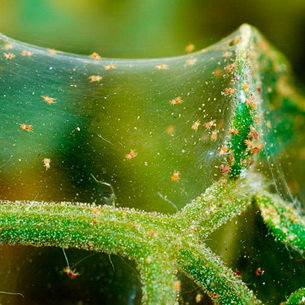
A decoction of onion peel or garlic is effective against spider mites. One of the components is boiled in water for 5 minutes, then diluted with boiled cooled water in a 1: 1 ratio, after which the plant is sprayed with it.


If aphids are found, the leaves should be wiped with a concentrate of laundry soap. To make it, a piece of soap is rubbed on a grater and dissolved in boiled cooled water in a 1: 1 ratio. You can wipe the leaves by hand or use a sprayer.


If scale insects have settled on the bush, you will have to resort to the help of a chemical preparation, since it is difficult to fight this insect with folk remedies. Actellik acts most effectively in this case.
The lack of flowers is also due to the lack of potassium and phosphorus in the soil. It is necessary to feed the plant with fertilizer containing these substances. But even with an excess of fertilizers, Ugandan Clerodendrum will not bloom.
Perhaps the flower has not been transplanted for a long time and the soil has depleted its resource.
Another common reason for the lack of flowering is oversized dishes, in which the shrub mainly builds up green mass.
How to prune clerodendrum branches correctly
If you want to have a vine in the form of a medium-sized tree, then you need to know how to properly cut the branches of the clerodendrum. When forming a young flower, side shoots should be removed, leaving one larger, stronger and healthier one. All these works are carried out until the plant reaches 0.8 m in size. The next step will be to pinch the top of the formed trunk. This will allow the lateral shoots to start actively developing. In the following years, the emerging twigs should be pinched to form the crown. In this case, you should remove all shoots that may additionally appear in the clerodendrum on the ground.
Do not be upset if you notice that dry twigs have appeared on your vine. The fact is that some species of this plant themselves regulate growth by drying out excess shoots. For clerodendrum with such a feature, the removal of dried shoots should be included in pruning at home.
Pests

A plant infected with whiteflies can be recognized by small light dots on the leaves, their yellowing and dropping. From a disturbed plant, small insects fly up in a swarm. To destroy them, the bush is sprayed with soapy water, garlic water, tobacco or dandelion infusion. If there are too many insects, insecticide preparations "Actellik", "Tanrek", "Zeta" help. When infected with a mealybug, a fluffy white bloom in the form of cotton wool appears on the leaves and shoots. Affected plants do not develop well. You can remove them by treating the bushes with a soap-alcohol solution. An infusion of cyclamen tubers, tobacco, dandelion also helps well.
Spider mites are very small arthropods, invisible to the armed eye. A thin web on the leaves speaks of their infection. They die and become cracked. The flower stops growing. To combat spider mites, preparations of acaricidal action are suitable. Increasing the humidity of the air also helps.
When infected with aphids, the foliage becomes covered with sticky insect secretions, deforms and curls. Insects settle in large colonies on the back of the leaf plates. At the initial stage of infection, folk methods help: treatment with soapy water, wormwood decoction, tobacco or dandelion infusion. If they do not help, the bush is treated with Aktellik, Decis, Fitoverm insecticides.
Scales and false scutes on the leaves look like small rounded yellowish spots. They feed on plant juices, cause foliage to wilt and dry out. Visible insects are removed by wiping the leaves with turpentine and treating with soapy water.Then the bush is sprayed with preparations "Fitoverm", "Fufanon", "Aktellik".
Difficulties of home care
Particular attention should be paid to the phyto-friend during periods of rest and coming out of it. With the onset of winter, it should be placed in a place where the temperature will be around 15 ° C. Watering should be reduced to a minimum, but make sure that the soil in the pot does not dry out completely
Important! In winter, it is impossible to spray, fertilize, or put the plant in a warm place. Since watering is reduced, many growers forget about their indoor friend and may miss the appearance of the first flower buds.
With their hatching, an active period of plant care should begin, this is approximately the end of February and beginning of March:
Since watering is reduced, many growers forget about their indoor friend and may miss the appearance of the first flower buds. With their hatching, an active period of plant care should begin, this is approximately the end of February and beginning of March:
Mandatory trimming. The length of the shoots should be reduced by one third. If long lashes are formed, you need to remove a minimum of length, if you want to create a tree, you can leave 10 cm shoots. The smaller the shoots of the plant, the larger and thicker its flowers will be.
Transplant or renewal of the topsoil. The flower slept in winter, and during the active growth period it needs a lot of nutrients that should be in its soil
Transplanting is unnecessary if the roots of the plant have not reached the bottom of the pot.
After transplanting and pruning, it is important to provide the clerodendrum with warmth and ample light.
In conditions of awakening, the flower needs daily watering with the obligatory removal of excess water from the pan.

An example of how to properly cut a clerodendrum
Biological characteristics
Clerodendrum Thomsoniae is a type of flowering vine from the genus Clerodendrum, Verbenaceae family. It is an evergreen plant that can grow up to 4 m in height. Its leaves are bright green, oblong, up to 17 cm long, on average 13-14 cm with pronounced veins. Five-petalled flowers up to 2.5 cm in diameter are formed in clusters from 8 to 20 pcs. on one in sympodial inflorescences. The color ranges from pure white to lilac and crimson hues. Corolla is red with 5 petals and 2 cm long.

Clerodendrum Thompson
Plant name
Translated from the Greek “Kleros” means “fate, lot, luck”, and “Dendron” means “tree”. The name of the flower can be different: bleeding glory, grapes with a bleeding heart, begflower, but these names can also be applied to the other 400 species of the genus Clerodendrum.
Where the name comes from is unknown to the end. There are several versions:
- In the nineteenth century. lived Scottish missionary D. Thompson, who came to Cameroon to collect flowers for the Royal Botanic Gardens in Kew and the British Museum.
- George had a nephew W. Cooper Thompson, who was also a missionary, but already in Nigeria, and it was in his honor that the plant was named (originally a bleeding heart, after it was renamed to Clerodendrum Thompson).
- William was married, and after his wife died, he asked to name a flower after her. Therefore, sometimes you can hear the name Clerodendrum of Mrs. Thompson.
In general, there is no exact version, but it is clear that the name revolves around one family of missionaries.
Note! The genus of plants is very rich, but mostly cultivated are Clerodendrum Mehonsol, Thompson, Wallich, Ugandan, Filipino, Spezum, Tripartite and Bunge
Natural habitat
The plant was brought from western Africa, or rather from Cameroon westward to Senegal. In some regions, it has not been possible to cultivate it, so it has been naturalized.
Pests and diseases
Of all the harmful insects, spider mites and whiteflies can infect clerodendrum.Whiteflies hide on the underside of the leaves, and on the upper one there is a shiny bloom from whitefly feces - honeydew, or honeydew. The spider mite is too small for you to see, but it shows up with white dots on the underside of the leaf blade and a barely visible cobweb on the leaves. You can fight these pests with the same insecticide: dilute one ampoule of actellik in a liter of water and spray the plant. The treatment can be repeated four times at intervals of three days.
The plant is quite resistant to diseases, but insects can cause a lot of trouble for a grower.
-
Spider mite.
The parasite can be identified by the presence of cobwebs in the internodes, the sluggish state of the foliage. It is preferable to fight insects with soapy water, if the infection is strong, a chemical agent is used. As a preventive measure, clerodendrum should be sprayed regularly. -
Aphid.
The plant slows down in growth, leaves and buds are deformed and fall off. The affected areas of the plant must be cut off, and the remaining bush must be treated with a chemical until the aphid disappears completely. -
Whitefly.
This white midge is clearly visible on the plant. The larvae are located on the lower parts of the leaves; in the process of their vital activity, a white, sugary bloom appears on the plant. As a result, the foliage deforms and dries up. To combat insects, you need to completely collect the affected leaves from the plant, and spray the liana with a chemical agent three times a day.
Clerodendrum does not bloom.
Very often, on flower forums, beginners try to find out from experienced flower growers why their clerodendrum does not bloom, and each time they are amazed at how simple the reason for their sadness is. Moreover, when they are convinced that everything depends only on them, and get down to business, then the problems with other colors are solved by themselves. And the reason is always the same: the rules for growing a plant have been violated. In the case of clerodendrum, most often flowering does not occur due to improper wintering of the plant.
How to make clerodendrum bloom.
So what if Clerodendrum is not blooming? In order for your clerodendrum to bloom in the spring, it needs to organize a cool winter. Once flowering is over, gradually reduce watering to the plant and move the flower to a cool - no warmer than 15 ºC - room. Optimal wintering conditions are 12 ºC and purely conditional watering just to keep the plant from drying out. With this content, within one and a half to two months, the clerodendrum will rest and gain strength for a new season of active growth. As soon as you notice that the clerodendrum has begun to release new shoots, gradually increase the watering, prune and, if necessary, transplant the plant, transfer it to its usual place and resume feeding. Make sure that the soil near the clerodendrum is nutritious - sometimes the plant does not bloom due to the fact that it has not been transplanted for a long time. Another reason for delayed flowering and even dropping of buds can be insufficient lighting.
Clerodendrum turns yellow.
If clerodendrum turns yellow leaves in spring or summer, then the reason may be a lack of moisture in the soil - water the plant more often or more abundantly so that there is always water in the pan. Sometimes the cause of yellow spots on the leaves of clerodendrum is chlorosis, which is cured by feeding the plant with iron-containing preparations.
Clerodendrum leaves fall.
If leaf fall begins after flowering, then most likely this is a natural autumn process for deciduous - the leaves turn yellow and fall off all autumn and winter, leaving bare shoots. But in spring and summer, the leaves should not fall off, so re-read the rules for caring for the plant and correct your mistakes or change the location of the clerodendrum.
Growing conditions and care
The most important thing for a plant is the correct temperature regime, and it can survive the rest of the shortcomings without much loss. Too long breaks in watering and feeding will lead to a loss of decorative appearance. With its appearance, the clerodendrum tells what it lacks.
In order for it to grow well and bloom profusely, it is necessary to create suitable conditions for the plant:
- lighting needs diffused, medium intensity;
- it is better for him to determine his place of residence on the west or east window;
- the soil is watered as the soil dries up, abundantly, only with settled water at room temperature;
- fertilization is carried out 2 times a month during the flowering period, from April to September;
- humidity for clerodendrum requires high, I spray it every day, for which he thanks the long flowering;
- the temperature difference (cool wintering) is important, imitating the natural cycle and stimulating the laying of flower buds.
Pruning
A feature of Thompson's clerodendrum is the rapid growth of green mass. If you leave things to chance and do not touch the processes, then they stretch up to 3.5 meters, acquiring a very untidy appearance. Pruning is a must for this plant.
I spend it at the end of February. 3 types of crown formation are allowed: ampelous, shrub, standard. I liked the curly version more, for which I hardly touch the length, but I pinch the side shoots and carefully cut out the root shoots.
When clerodendrum sleeps
The dormant period of the flower is in autumn and winter. After the end of flowering, I remove the remains of the peduncles and transfer the flower pot to a cool corridor. Watering is reduced, but it is not worth allowing the earthen coma to completely dry out.
The signal that the "hibernation" is over is the appearance of new tender leaves. So it's time to transplant the clerodendrum into a larger pot and take it to a warm room.
 Thompson's Clerodendrum prefers diffused light. Monocromatico
Thompson's Clerodendrum prefers diffused light. Monocromatico
Reproduction
To get a new plant, you can use two methods of propagation:
- cuttings;
- seeds.
For seed propagation, it is necessary at the beginning of spring to prepare a small container with nutrient soil, consisting of peat and sand, and place seed material on its surface. The soil in the container should be abundantly moistened with a spray bottle and covered with plastic wrap to create a greenhouse effect. The planting containers should be placed in a warm and well-lit room. Young growers should not forget to regularly ventilate the container and moisten the soil.

Cutting is the most popular and easiest way to get a new plant. For its implementation, it is necessary to put the cut shoots in water, into which you can add an accelerator of the growth of the root system. After the last petiole has been formed, it can be rooted in small technical containers, the diameter of which should not be less than 60 mm.


Reproduction and pruning

What is the best way to propagate "innocent love"? This is best done with cuttings. The root panicle forms on them quickly enough. This usually only takes a couple of weeks. How to root a stalk? Very simple, put it in a container of water and wait for the roots to appear.
Change the water to clean water if necessary. Then plant the cutting in a pot (6-7 cm in diameter will be enough) and cover with a transparent cap until young shoots grow.
"Pure love" is propagated by seeds as well. Of course, compared to grafting, sowing seeds is more difficult. But sometimes this is the only way to grow clerodendrum, if, for example, the variety you like can be ordered only by seeds. Sow in the ground in mid-March.

Place the container covered with a transparent lid in a warm place, but so that light has access to it. There will be a lot of sun - great.You will have to wait for seedlings for a whole month, or even two, then watch the appearance of the first leaves. At this time, dive. You already know about the features of growing a flower.
Another thing to know is that Clerodendrum Thompson tolerates pruning well. When is the best time to prune this plant? In the spring, when the leaves begin to appear. Of course, you will be interested in how to properly cut the branches - aim to leave one third of the length.
Practice shows that you should not allow the growth of branches over 80 centimeters. Remove weak and dry branches. So the crown will be lush, with an abundance of flowers. By the way, you can give the plant any shape - curly twigs, a ball on a stem, hanging brushes. You can root the cut branches.

